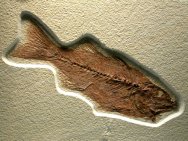|  Description:
This 50 million year old, Eocene-Era fossil fish comes from one
of the world's famous Laggerstatten, the Green River Formation in
Wyoming. A small portion of the fish fossils from Green River exhibits
such fine preservation. The significant extent of soft-tissue preservation
that makes the site famous is evident in this specimen. Description:
This 50 million year old, Eocene-Era fossil fish comes from one
of the world's famous Laggerstatten, the Green River Formation in
Wyoming. A small portion of the fish fossils from Green River exhibits
such fine preservation. The significant extent of soft-tissue preservation
that makes the site famous is evident in this specimen.
Mioplosus
labracoides is believed to have been a voracious predator among
the Green River fish fossils. Failure to find its numbers in mass
mortality leads to further conjecture that it was a solitary hunter.
A member of the Family Percidae, it has numerous relatives in Northern
Hemisphere fresh water as well as fossil relatives in Asia, Europe
and New Zealand. It is known as a predatory species as determined
from its many pointed teeth, and the fact that several have been
found with fish lodged in its throat. It may be related to the modern-day
pike of the genus Stezostedion.
Distinguishing
features include double dorsal fins and a fan-like tail. Mioplosus
is uncommon in the Green River formation, especially the fish of
this size and of this exceptional quality of preservation (both
bone detail and some soft-tissue preservation are evident).
About
the Green River Formation: Class Actinopterygii, the ray-finned
bony fishes, comprise almost half of all known species of vertebrates,
some 20,000 extant species. There are numerous locations worldwide
that are noted for wondrous preservation of bony fishes, and the
Green River formation that covers some 25,000 square miles of SW
Wyoming, west Colorado and east Utah is one of the premier examples.
The formation is one of the largest lacustrine sedimentary accumulations
in the world, and spans the period from 40 to 50 million years ago
during the Eocene Epoch.
During
the Eocene, based on the fossil record, the region was sub-tropical
to temperate. Some 60 vertebrate taxa have been described from the
formation, including crocodiles, boa constrictors, and birds, as
well as abundant invertebrates and plants. The unusually excellent
preservation of the Green River fish fossils is usually attributed
to a combination of two factors: 1) a cold period during the Eocene
that would have caused dead fish to sink faster due to a less inflated
swim bladder; and 2) the great depth of the lakes and the consequent
anoxic conditions that would have often prevented scavengers from
disturbing the carcasses.
|